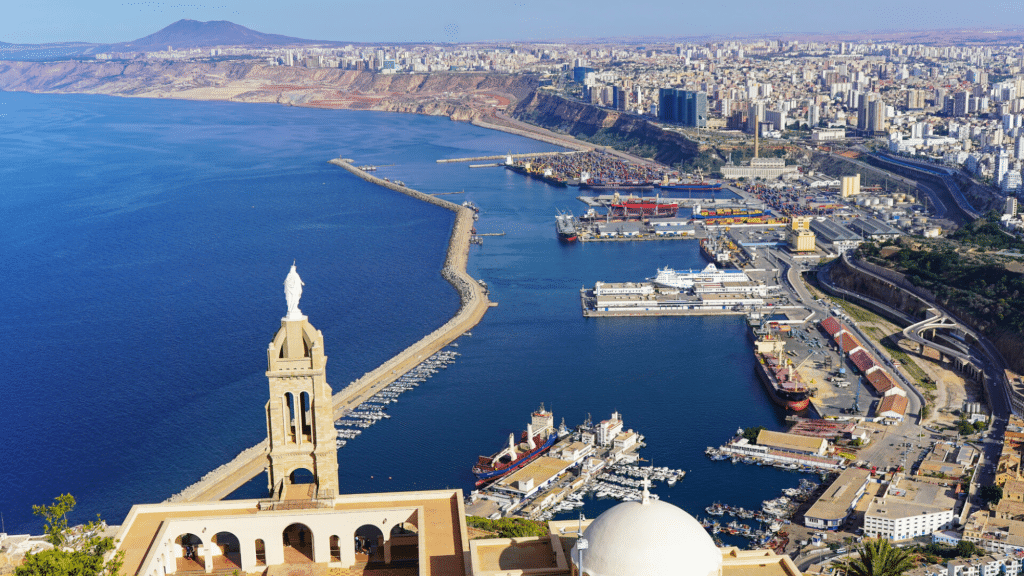Have you ever wondered why more people don’t talk about Algeria, even though it’s so vast and rich in history?
Maybe it’s because its stories are still waiting to be shared.
Well, Algeria is the largest country in North Africa, with a mix of Arab, Berber, and French cultures that shape its unique identity.
It’s a land of contrast—where the Sahara Desert meets the Mediterranean Sea, and ancient Roman ruins stand beside Islamic buildings.
In this blog, you will come across everything in detail that truly makes Algeria special.
Geography & Natural Features of Algeria
Algeria has many different landscapes, from huge deserts to the Mediterranean Sea. This mix of nature and history has helped shape the country’s culture and identity.
1. Largest African Country
Algeria holds the distinction of being Africa’s largest country, with a landmass that exceeds that of many countries combined. Its vast expanse stretches from Mediterranean shores to Saharan sands.
- Algeria is the largest country by area in Africa
- It spans over 2.38 million square kilometers
- About 80% of this land is covered by the Sahara Desert
2. Mediterranean Coastline
The northern edge of Algeria meets the Mediterranean Sea, characterized by dramatic cliffs and golden beaches. This coastal strip has attracted settlers and traders for thousands of years.
- Algeria has a 1,600 km coastline along the Mediterranean Sea
- The coast features numerous beaches and small islands
- Many fishing communities exist along this northern border
3. Atlas Mountains
The Atlas range forms a natural barrier between the coast and the desert. These ancient formations create microclimates that support diverse plant and animal communities.
- The Atlas Mountain range runs across northern Algeria
- Mount Tahat is the highest point at 2,908 meters
- These mountains create distinct climate zones in the country
4. Saharan Sand Seas
The massive sand seas of Algeria contain some of the most striking dune formations on Earth. These golden oceans shift and change with the desert winds, creating an ever-changing landscape.
- The Grand Erg Oriental and Grand Erg Occidental are vast sand seas
- Some dunes reach heights of over 300 meters
- These regions experience extreme temperature fluctuations
5. Indigenous Palm Groves
Oasis palm groves stand as green islands amid the Saharan expanse, providing vital shade and food. These natural resources have made human settlement possible in otherwise harsh environments.
- Date palms grow throughout the oases of southern Algeria
- These groves have sustained communities for thousands of years
- Algeria produces over 1 million tons of dates annually
6. Tassili n’Ajjer National Park
This remarkable national park contains one of the most important collections of prehistoric art in the world. Its strange rock formations create an almost lunar landscape, unlike anywhere else on Earth.
- This UNESCO World Heritage site contains ancient rock art
- The park features unusual rock formations shaped by erosion
- Some artwork dates back to 10,000 BCE
Fact Related to History & Culture of Algeria
Algeria’s history includes old civilizations, strong empires, and hard times. All of these have shaped its culture and still affect the country today.
7. Ancient Civilization
The Berber people established some of North Africa’s earliest known civilizations in what is now Algeria. Their cultural legacy continues to affect the nation’s identity and traditions today.
- Algeria was home to the ancient Berber civilization
- Berber kingdoms existed since at least 200 BCE
- Many Algerians today have Berber ancestry
8. Roman Presence
Roman changed northern Algeria with cities, roads, and agricultural systems that altered the landscape. The designs and buildings from this period rank among the best-preserved Roman ruins anywhere.
- Romans controlled northern Algeria for several centuries
- The Roman ruins at Timgad and Djémila remain well-preserved
- Roman agricultural techniques converted the coastal regions
9. Ottoman Rule
The centuries of Ottoman control left a lasting mark on Algerian culture and art. This period saw Algeria become an important Mediterranean power with a significant maritime impact.
- The Ottoman Empire controlled Algeria from 1515 to 1830
- This period shaped much of Algeria’s cultural identity
- Ottoman architecture can still be seen in older cities
10. French Colonial Period
The long French occupation represents one of the most significant chapters in Algerian history. This difficult era fundamentally altered social structures and sparked the revolutionary movement.
- France colonized Algeria from 1830 to 1962
- This 132-year occupation was one of the longest in Africa
- The fight for independence cost hundreds of thousands of lives
11. War of Independence
Algeria’s struggle for freedom became a symbol for colonized peoples worldwide and shaped the nation’s modern identity. The conflict was one of the most significant independence movements of the 20th century.
- Algeria’s independence struggle lasted from 1954 to 1962
- The conflict became a symbol of anti-colonial resistance
- July 5, 1962, marks the country’s Independence Day
12. Cultural Mosaic
Algerian culture represents a rich shade woven from multiple historical elements and regional traditions. This cultural wealth is evident in everything from music and literature to clothing and cuisine.
- Algerian culture blends Arab, Berber, French, and Mediterranean influences
- This mix is seen in music, food, language, and architecture
- Regional variations exist between coastal, mountain, and desert areas
13. Film History
Algerian cinema gained international recognition for its powerful storytelling and social commentary. Many films address themes of colonialism, identity, and social change.
- Algeria has had a rich cinematic tradition since the 1960s
- “The Battle of Algiers” (1966) is studied in film schools worldwide
- Algerian cinema often focuses on social themes and historical events
Facts Related to Food & Cuisine of Algeria
Algerian cuisine is a flavorful mix of Mediterranean, Arab, and Berber elements, offering a rich variety of dishes that showcase the country’s history and agricultural abundance.
14. Couscous Origins
Couscous stands as Algeria’s most famous culinary contribution to world cuisine. This grain dish has ancient roots and remains central to family gatherings and celebrations.
- Couscous, a staple food, originated in North Africa
- Traditional preparation involves steaming over a stew
- Friday couscous meals are an important family gathering
15. Coffee Culture
Coffee represents more than just a beverage in Algeria—it’s a social institution with its own customs and rituals. The preparation and sharing of coffee mark essential moments in daily life.
- Coffee shops are social centers in Algerian cities
- Algerian coffee is often served strong and sweet
- These establishments have been community meeting spots for centuries
16. Unique Pastries
Algerian sweet creations reflect centuries of cultural exchange and local innovation. Many recipes have been passed down through families for generations, with each region adding its own touches.
- Makroud are semolina cookies filled with dates
- Kalb el Louz is a sweet semolina cake soaked in syrup
- These treats are central to celebrations and holidays
17. Mediterranean Diet
Cooking shares many healthy characteristics with other Mediterranean food traditions. Fresh ingredients and simple preparation methods highlight natural flavors.
- Olive oil is a foundation of Algerian cooking
- Fresh vegetables and fruits feature in most meals
- Fish dishes are common along the coastal regions
18. Mint Tea Tradition
The ritual of preparing and serving mint tea is an art form and social custom in Algeria. This tradition symbolizes welcome and respect for guests in Algerian homes.
- Green tea with mint is a symbol of hospitality
- The tea is poured from a height to create a froth
- Refusing tea can be considered impolite in some settings
List of Facts Related to Cities & Architecture in Algeria
From ancient cities to colonial influences, Algeria’s style reflects its diversified history, offering an insight into the country’s past through its urban landscapes.
19. Casbah of Algiers
The old part of Algiers is a unique place that was built long before modern cities came. Its narrow streets and white buildings give it a unique look that has inspired many artists and writers.
- This UNESCO site is a historic urban center
- Its winding streets form a complex maze-like structure
- The architecture was adapted to the steep hillside location
20. Constantine’s Bridges
Constantine is built on a big rocky hill. To connect its parts, people built strong bridges over deep gaps. However, these bridges show smart and creative thinking.
- The city of Constantine sits atop a rocky plateau
- Seven major bridges connect different parts of the city
- The Sidi M’Cid suspension bridge spans a 175m gorge
21. Oran’s Spanish Impact
Oran’s architecture and culture show clear signs of its complex history with Spain. The city stands as an example to the cultural exchanges that shaped Algeria’s coastal regions.
- Oran shows strong Spanish architectural influences
- The city was under Spanish control for several periods
- Its port has been important since the 10th century
22. M’zab Valley Towns
The fortified settlements of the M’zab Valley demonstrate extraordinary planning and adaptation to harsh desert conditions. These communities represent a thousand years of continuous human habitation.
- Five fortified towns in the M’zab Valley form a UNESCO site
- These 10th-century settlements show careful urban planning
- Homes are built around mosques and community spaces
23. Algiers’ French Quarter
The newer part of Algiers, built during colonial times, looks very different from the old Casbah. This shows how Algeria’s history has many other parts.
- Wide boulevards and European-style buildings characterize this area
- The quarter was constructed during colonial times
- It contrasts with the older, more compact Casbah area
Nature & Wildlife Facts About Algeria
Algeria is home to a unique wildlife and plant species, with diverse ecosystems that range from desert to mountain habitats, each supporting amazing adaptations for survival.
24. Barbary Macaques
These intelligent primates have adapted to life in Algeria’s northern mountains over thousands of years. Their social groups maintain complex relationships and communication systems.
- These monkeys are found in the Atlas Mountains
- They are the only primates native to North Africa
- Their population has dropped due to habitat changes
25. Fennec Fox Habitat
The fennec fox has become an unofficial symbol of the Sahara due to its unique, oversized ears. These small canids have remarkable adaptations for desert survival.
- The fennec fox, with its large ears, is native to Algeria
- These nocturnal animals are adapted to desert conditions
- Their ears can be up to 15 cm long to help cool their bodies
26. Cheetah History
The swift Saharan cheetah once ranged widely across Algeria’s varied landscapes. Their declining numbers highlight conservation challenges in North Africa.
- Cheetahs once roamed freely across Algeria
- The Saharan cheetah is now critically at risk
- Less than 250 individuals may remain in the wild
27. Bird Migration Routes
Algeria’s position between Europe and sub-Saharan Africa makes it crucial for migratory birds. Countless winged travelers pass through or winter in Algerian habitats each year.
- Algeria sits on important bird migration paths
- Wetlands along the coast host thousands of birds seasonally
- Over 400 bird species have been recorded in the country
28. Native Plants
Plants in Algeria have found smart ways to live in tough places. However, some of these plants are also useful for science and medicine.
- The Sahara contains plants with amazing drought adaptations
- Alfa grass grows in the high plateaus and has industrial uses
- Many plants have traditional medical applications
Facts Related to The Economy & Resources of Algeria
Algeria’s economy is fueled by its vast natural resources, including oil and gas, while the country also focuses on developing renewable energy sources like solar power.
29. Oil and Gas Production
Hydrocarbon resources form the backbone of Algeria’s modern economy and global connections. These natural resources have funded major national development projects.
- Algeria ranks among the top natural gas producers globally
- Oil and gas account for about 95% of export earnings
- The country has the 10th-largest natural gas reserves worldwide
30. Solar Power Potential
The abundant sunshine of the Sahara represents a vast untapped energy resource. And Algeria is positioned to become a leader in solar power generation.
- Algeria receives some of the highest solar radiation on Earth
- The Sahara could generate substantial renewable energy
- Several large-scale solar projects are under development
31. Ancient Water Systems
The foggara water management approach demonstrates remarkable ancient engineering that remains functional today. These systems demonstrate how past generations solved critical resource challenges.
- Foggaras are underground water channels
- These systems have supplied desert communities for centuries
- They work by gravity and require no mechanical pumps


























